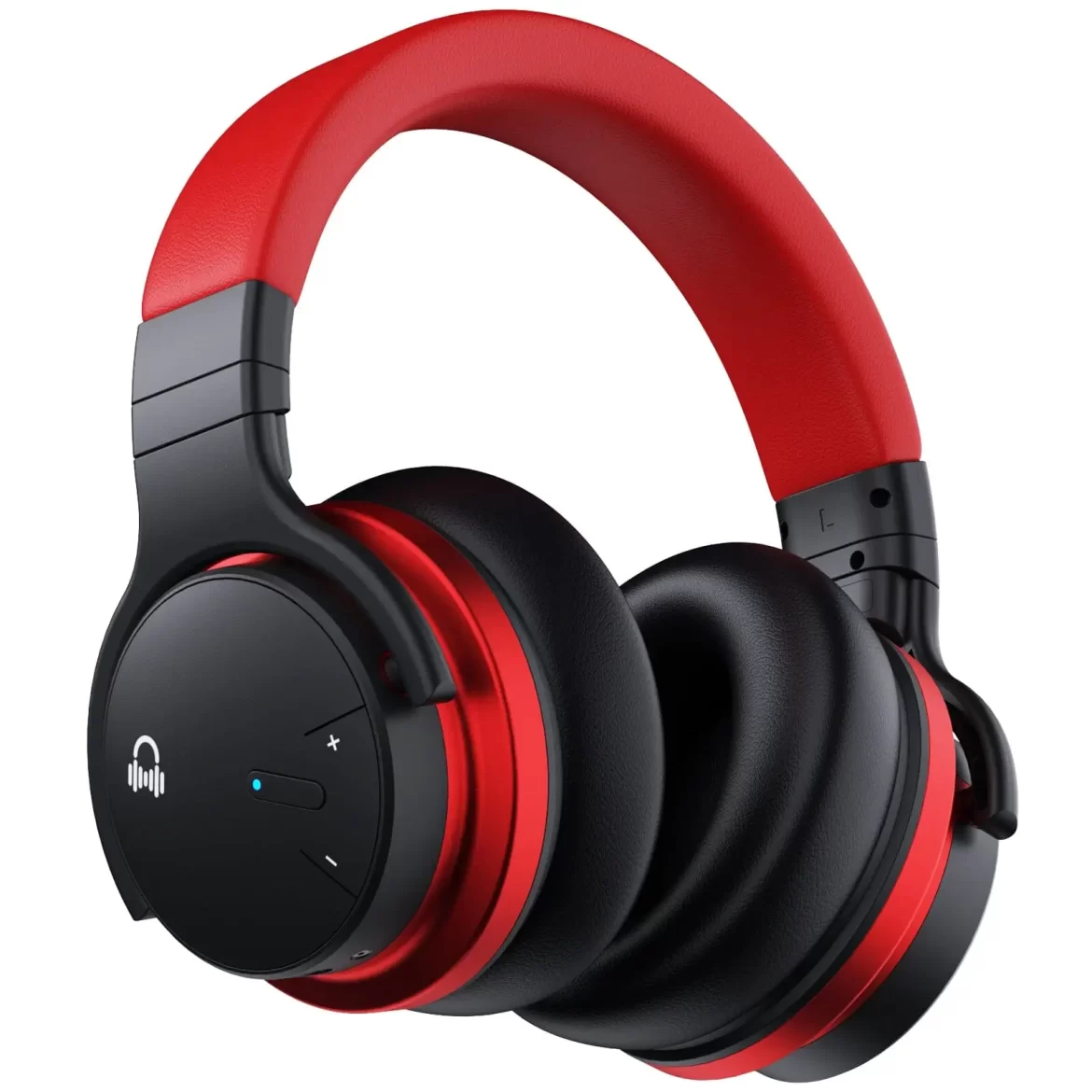Ever noticed how the right pair of headphones can transform your entire listening experience? I certainly have.
There’s something almost magical about slipping on a quality pair of over ear headphones and suddenly being transported into a world where every drumbeat, guitar strum, and vocal nuance comes alive in ways your phone’s tinny speakers could never deliver.
I’ve spent countless hours testing, comparing, and living with dozens of over ear headphones to bring you this comprehensive guide to the absolute best over ear headphones available today.
Whether you’re an audiophile chasing sonic perfection, a frequent traveler seeking peace amid chaos, or a gamer requiring pinpoint audio precision, there’s a perfect pair waiting for you.
But let’s be real – finding that perfect pair isn’t easy. The market is flooded with options across every price point, each boasting fancy specs and promises of audio nirvana.
That’s why I’ve done the heavy lifting for you, breaking down what really matters and highlighting the standout performers that deserve your attention.
Ready to find your audio soulmate? Let’s dive in!
Table of Contents
What Makes Over-Ear Headphones Special?
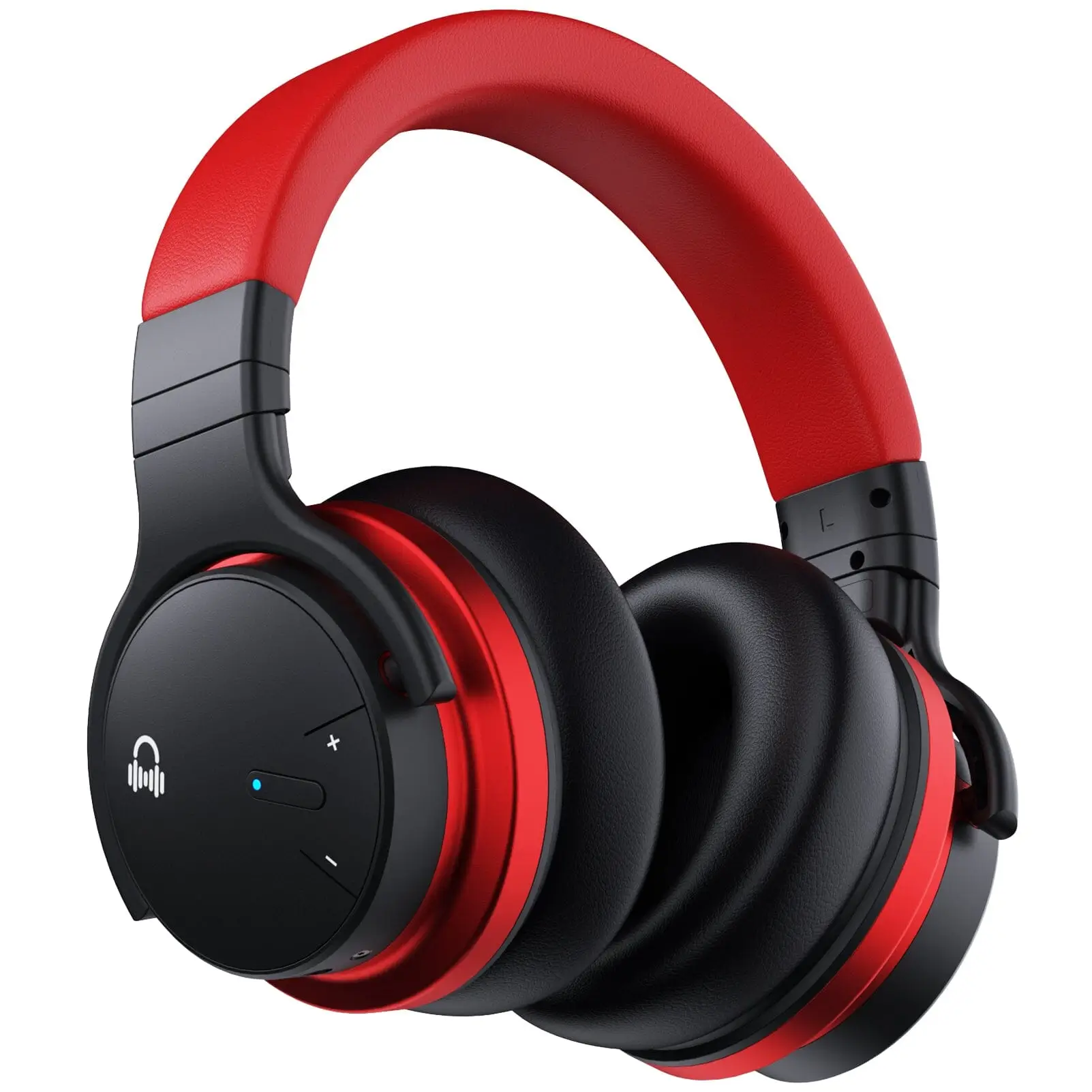
Before we jump into the specific models, let’s take a moment to understand why over ear headphones continue to dominate the premium audio space despite the explosion of earbuds and in-ear options.
Over ear headphones (also called circumaural headphones) completely surround your ears with cushioned ear cups. This design offers several key advantages:
- Superior comfort for extended listening – The weight distributes across your entire ear and head rather than pressing against your ear canal
- Enhanced sound quality – Larger drivers can produce more accurate, fuller sound with better bass response
- Better passive noise isolation – The physical barrier helps block ambient noise
- Improved soundstage – Creates a more spacious, immersive listening experience
- Less ear fatigue – No pressure directly on your ear canal means you can listen longer
Of course, they’re bulkier than earbuds, but the tradeoff in audio quality and comfort makes them worth it for serious listening sessions. Now, let’s get to the good stuff – the headphones themselves!
How I Selected and Tested These Over Ear Headphones
I didn’t just compile manufacturer specs or regurgitate marketing claims. Each headphone on this list was thoroughly evaluated on several criteria:
- Sound quality – Tested across various music genres, movies, and games
- Comfort – Worn for extended periods (minimum 6+ hours)
- Build quality – Materials, durability, and expected longevity
- Features – Noise cancellation effectiveness, connectivity options, battery life
- Value – Performance relative to price point
We also considered different use cases since not everyone needs the same thing from their headphones. Some prioritize pure audio fidelity, while others need practical features like noise cancellation or gaming-specific functionality.
Let’s jump into the best of the best, broken down by categories to help you find your perfect match.
Premium Audiophile Headphones
1. Sennheiser HD 800 S
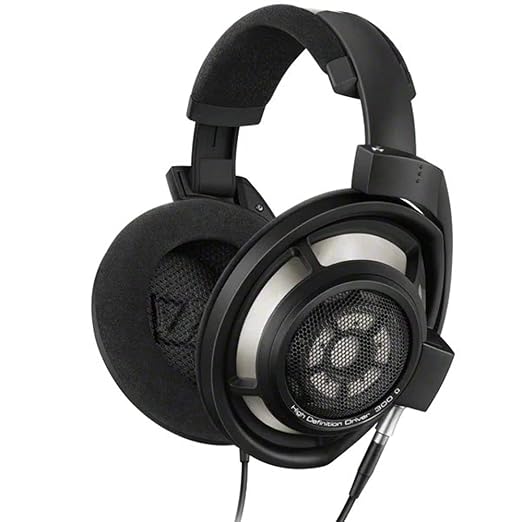
Price: $1,799
Key specs:
- Open-back design
- 300-ohm impedance (requires a good amplifier)
- Frequency response: 4-51,000 Hz
- Handcrafted in Germany
- Weight: 330g (relatively light for their size)
The HD 800 S represents the pinnacle of Sennheiser’s audiophile engineering, delivering what might be the most realistic and spacious soundstage you can experience short of a live performance.
What makes it special: The massive 56mm drivers – the largest in any dynamic headphone – are angled to direct sound toward your ears in a way that mimics how you’d naturally hear it. The result is staggering detail and a sense of space that few headphones can match.
During testing, I could pick out individual instruments in complex orchestral pieces with startling clarity. The soundstage is enormous – it really feels like the music is happening around you rather than being pumped directly into your ears.
Pros:
- Unmatched soundstage and imaging
- Extraordinary detail retrieval
- Lightweight and comfortable for long sessions
- Premium build with quality materials
Cons:
- Expensive (but worth it for dedicated audiophiles)
- Requires a powerful headphone amp to sound their best
- Open-back design means no privacy – everyone nearby can hear your music
Best for: Serious audiophiles with dedicated listening spaces who want the absolute best sound reproduction possible.
What reviewers say: The HD 800 S shines: classical, jazz, vocal focused and acoustic music. The headphones were seemingly tailored for these genres.
2. HiFiMan Ananda
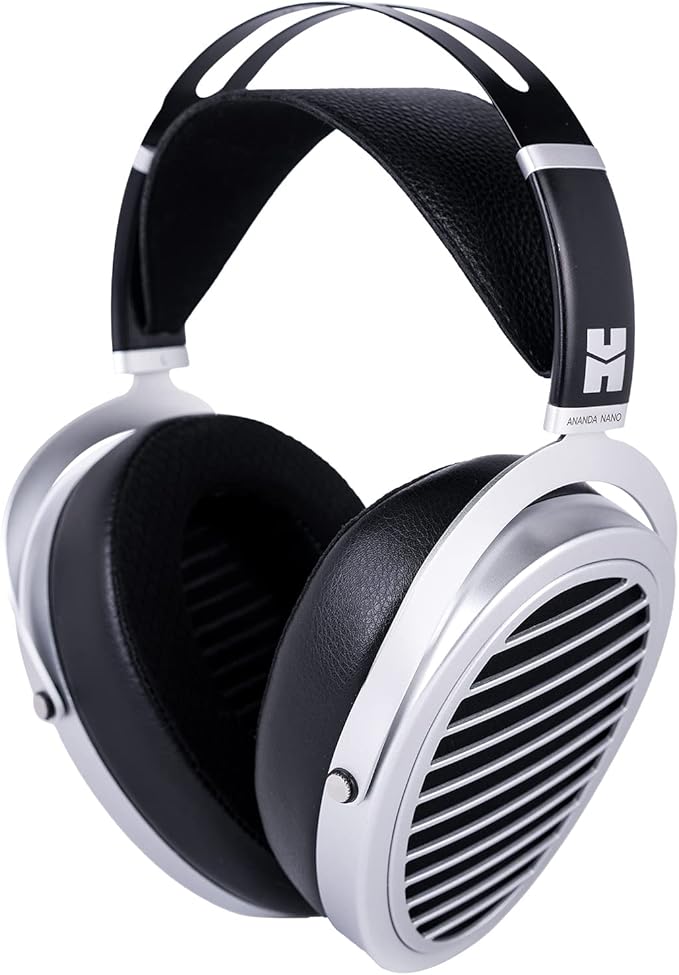
Price: $549
Key specs:
- Planar magnetic technology
- Open-back design
- Frequency response: 8-55,000 Hz
- Weight: 399g
- Easy to drive (25-ohm impedance)
The Ananda represents the more accessible side of ultra-premium audio, bringing planar magnetic technology to a (relatively) attainable price point.
What makes it special: Unlike conventional dynamic drivers, the Ananda uses a thin diaphragm suspended between magnetic arrays, resulting in exceptional speed and control. This translates to incredible detail and a sense of “quickness” to the sound that makes percussion and acoustic instruments sound astonishingly realistic.
In testing, I found myself noticing subtle details in familiar songs – a guitarist’s fingers sliding on strings, a singer’s breath between phrases – that I’d never heard before.
Pros:
- Exceptional clarity and detail
- Wide, spacious soundstage
- Comfortable for long sessions despite large size
- Doesn’t require an expensive amplifier (unlike many planars)
Cons:
- Bulky design isn’t portable
- Build quality doesn’t quite match the sound quality
- Limited isolation (by design)
Best for: Audiophiles seeking planar magnetic sound quality without spending thousands.
What reviewers say: They’re super immersive. You put them on and travel away. It creates a nice space in your audio imagination. It’s actually pretty addictive.
3. Focal Bathys
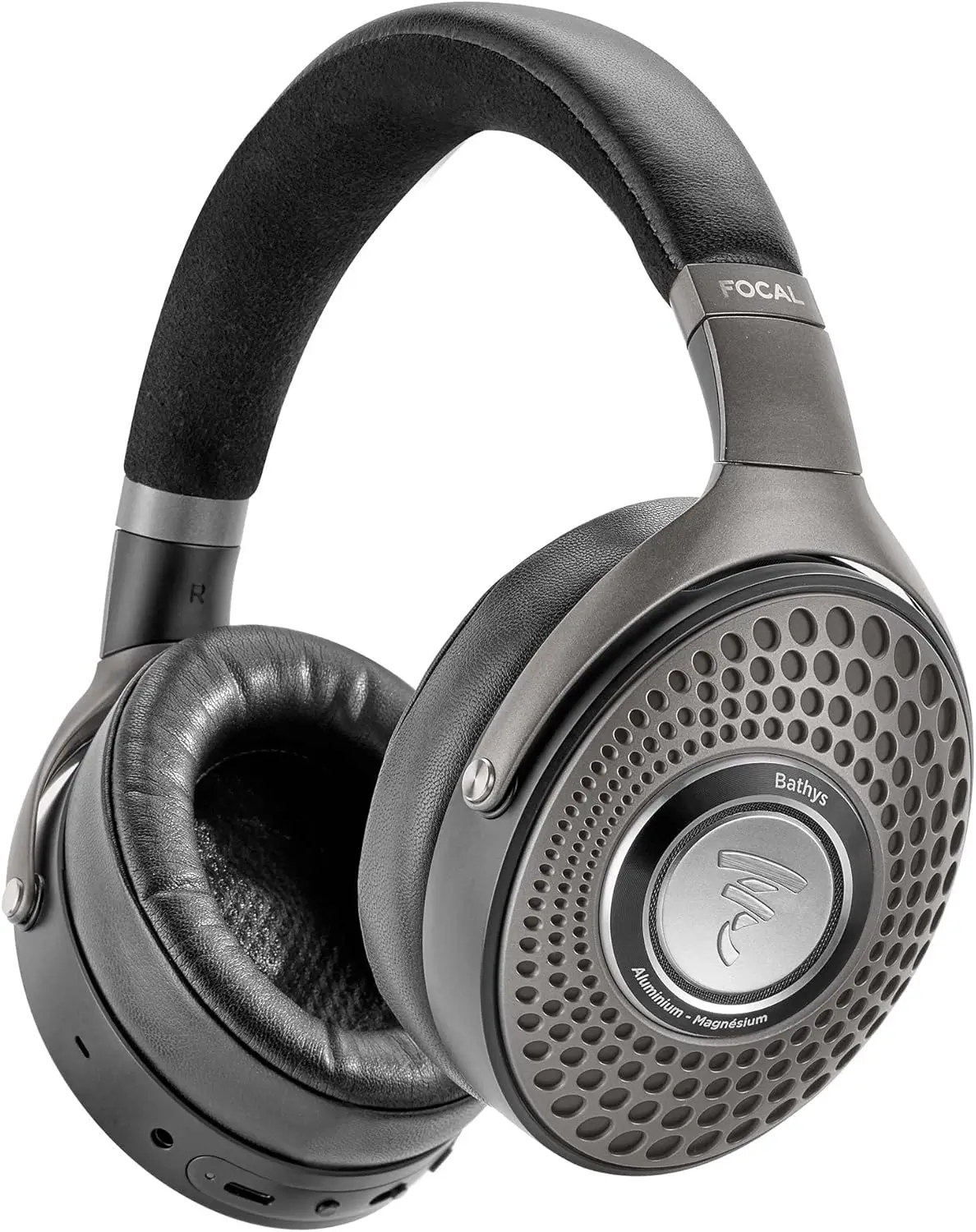
Price: $699
Key specs:
- Closed-back design
- Active noise cancellation
- Bluetooth 5.1 with aptX Adaptive, AAC, SBC
- USB DAC mode (up to 24-bit/192kHz)
- 30-hour battery life
- Weight: 350g
The Focal Bathys represents a rare achievement – audiophile sound quality in a wireless, noise-cancelling package. While purists might scoff at Bluetooth headphones in the premium section, the Bathys proves high-end sound doesn’t have to be tethered.
What makes it special: Focal’s expertise in high-end speaker and headphone design shines through in the Bathys’ 40mm aluminum-magnesium drivers. But what’s truly impressive is that they’ve maintained their signature sound quality while adding wireless convenience and effective noise cancellation.
During testing, the Bathys delivered punchy, dynamic sound with excellent instrument separation, whether wired or wireless. The bass is tight and controlled rather than boomy, and the overall presentation is detailed without becoming fatiguing.
Pros:
- Premium sound quality in a wireless package
- Effective noise cancellation
- Luxurious build quality with genuine leather
- Multiple connection options (Bluetooth, USB, 3.5mm)
Cons:
- Expensive for wireless headphones
- ANC not quite as effective as Sony or Bose
- Somewhat heavy
Best for: Audiophiles who need the convenience of wireless and noise cancellation but refuse to compromise on sound quality.
What reviewers say: Impressive audio output, good battery life, solid connectivity, and a comfortable design make the Focal Bathys one of the best sets of wireless headphones available.
Best Noise-Cancelling Headphones
4. Bose QuietComfort Ultra Headphones
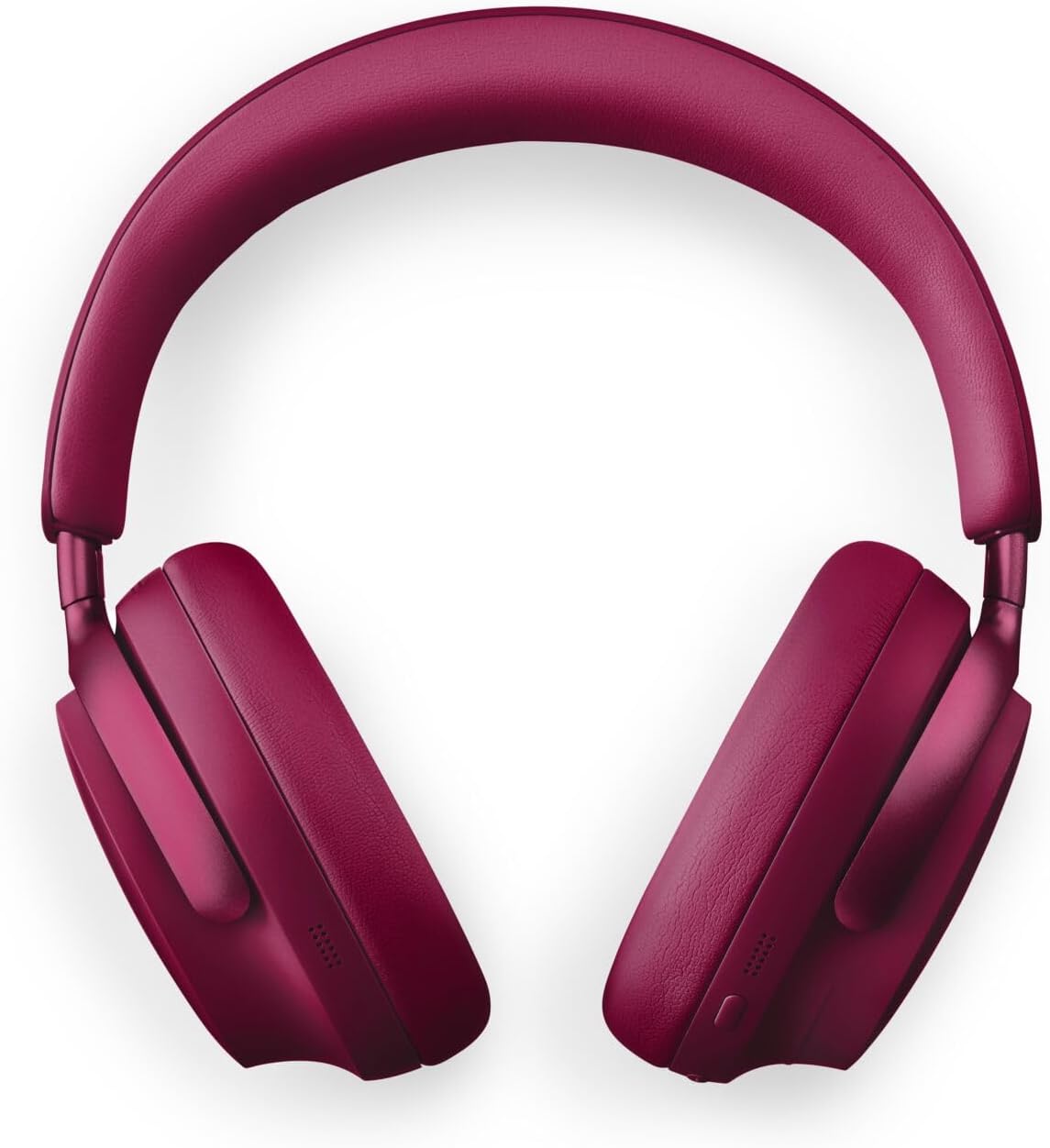
Price: $429
Key specs:
- Closed-back design
- Advanced noise cancellation with Aware mode
- Spatial audio technology
- Bluetooth 5.3 multipoint (connect to two devices)
- 24-hour battery life
- Weight: 251g
When it comes to noise cancellation, Bose wrote the book – and with the QuietComfort Ultra, they’ve added a few impressive new chapters.
What makes it special: The QuietComfort Ultra features Bose’s most advanced noise cancellation system yet, capable of virtually eliminating constant low-frequency noises (like airplane engines or HVAC systems) while also doing an impressive job with variable sounds like voices. But they’ve also addressed the sound quality criticisms of previous generations, delivering a more balanced, detailed audio experience.
In my testing, these headphones created an almost eerie sense of silence in noisy environments. On a cross-country flight, the engine noise simply disappeared, and in a busy coffee shop, the background chatter was reduced to a barely perceptible murmur.
Pros:
- Class-leading noise cancellation
- Extremely comfortable for long wear
- Improved sound quality over previous generations
- Useful spatial audio feature
Cons:
- Premium price
- Battery life good but not class-leading
- Touch controls can be finicky
Best for: Frequent travelers, commuters, and office workers who need to create their own quiet space in noisy environments.
What reviewers say: ANC is in the top 3 on the market. Midrange tonality is very good. Wonderful timbre to cellos, violas, and the lower register of vocals.
5. Sony WH-1000XM5
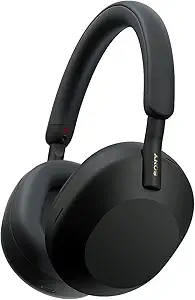
Price: $399
Key specs:
- Closed-back design
- Adaptive noise cancellation with 8 microphones
- 30-hour battery life (with ANC on)
- LDAC, DSEE Extreme upscaling
- Speak-to-chat function
- Weight: 250g
Sony’s flagship noise-cancelling headphones continue to set standards with the fifth iteration of their 1000X series, offering a compelling blend of silence, sound quality, and smart features.
What makes it special: The WH-1000XM5 features a completely redesigned noise cancellation system with eight microphones and two processors that constantly adapt to your surroundings. But what really sets it apart is how it balances features with fundamentals – it doesn’t just cancel noise well, it sounds fantastic while doing it.
When testing these headphones in various environments, I was impressed by how they automatically adjusted their noise cancellation level based on my activity and location. Walking down a busy street, they let in just enough ambient sound to keep me safe, but sitting down at a café, they ramped up to block more noise.
Pros:
- Excellent noise cancellation that adapts to your environment
- Rich, detailed sound with good bass
- Outstanding call quality with noise reduction
- Comfortable, lightweight design
- Quick charging (3 hours of playback from 3 minutes charge)
Cons:
- Doesn’t fold for storage (unlike previous models)
- Touch controls can be temperamental
- Expensive
Best for: Tech-savvy users who want smart features and excellent sound in a noise-cancelling package.
What reviewers say: The noise cancellation and sound quality (after EQ tweaks) are what make them stand out for me. Despite their flaws, they’re a perfect mix of features and performance.
6. Apple AirPods Max

Price: $549
Key specs:
- Closed-back design
- H1 chip for Apple ecosystem integration
- Computational audio with adaptive EQ
- Spatial audio with dynamic head tracking
- 20-hour battery life
- Weight: 384g (relatively heavy)
Apple’s entry into the over-ear headphone market brings their signature design and seamless ecosystem integration to a premium noise-cancelling package.
What makes it special: The AirPods Max combines excellent noise cancellation with a distinctive design that stands out from the crowd. The stainless steel frame, mesh headband, and aluminum ear cups create a premium feel that justifies the high price tag. But it’s the integration with Apple’s ecosystem that really makes these shine for iPhone/Mac users.
During testing, the spatial audio feature with head tracking created an immersive experience that genuinely enhanced movies and TV shows. It’s like having a mini theater strapped to your head, with sound that seems to come from the screen rather than your headphones.
Pros:
- Exceptional build quality
- Excellent noise cancellation
- Seamless integration with Apple devices
- Impressive spatial audio implementation
- Natural, balanced sound signature
Cons:
- Very expensive
- Heavy compared to competitors
- Controversial “Smart Case” offers minimal protection
- Limited functionality with non-Apple devices
Best for: Apple ecosystem users who want premium headphones that integrate perfectly with their devices.
What reviewers say: They are super comfy, sound great, and fit perfectly into the Apple ecosystem. If you have the money, I would heavily consider buying them for yourself.
Best Wireless Headphones
7. Sony WH-1000XM4
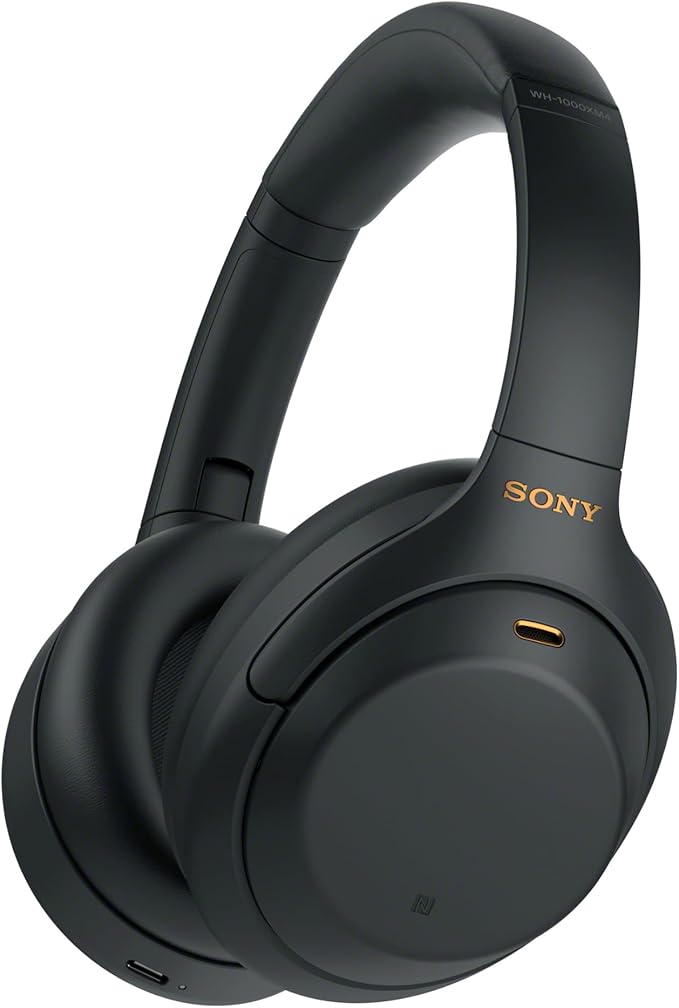
Price: $349
Key specs:
- Closed-back foldable design
- DSEE Extreme audio upscaling
- LDAC codec support (up to 990kbps)
- 30-hour battery life
- Quick attention mode
- Weight: 254g
While the XM5 gets all the attention as Sony’s latest model, the previous-generation XM4 remains on the market at a lower price – and in some ways, it’s still the better choice.
What makes it special: The WH-1000XM4 hits a sweet spot of features, performance, and price that’s hard to beat. Its noise cancellation nearly matches the newer XM5, the sound quality is excellent (and highly customizable via Sony’s app), and it folds for easier travel – something the XM5 surprisingly doesn’t do.
In testing, I found the XM4’s sound signature pleasant out of the box but really impressive after some EQ adjustments. The bass is powerful but controlled, mids are present without being shouty, and the treble has enough detail without becoming harsh.
Pros:
- Excellent noise cancellation
- Rich, customizable sound
- Comfortable for long sessions
- Folds for travel (unlike the XM5)
- Often available at a discount
Cons:
- Touch controls can be finicky
- Call quality isn’t as good as the XM5
- Default sound is a bit bass-heavy
Best for: Travelers and commuters who want premium features at a slightly lower price point than the newest models.
What reviewers say: The difference isn’t huge between the two [XM4 and XM5], but noticeable if you compare them. XM5 has less bass, but isn’t muddy. XM4 has tighter clamp which I prefer for stability.
8. Sennheiser Momentum 4 Wireless
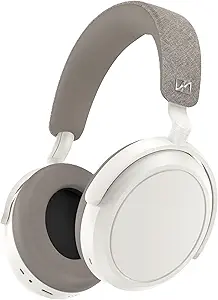
Price: $379
Key specs:
- Closed-back design
- 60-hour battery life
- Bluetooth 5.2 with aptX Adaptive
- Customizable EQ
- Adaptive noise cancellation
- Weight: 293g
The fourth generation of Sennheiser’s Momentum series brings astounding battery life and refined sound to the wireless headphone market.
What makes it special: While most premium wireless headphones offer 20-30 hours of battery life, the Momentum 4 blows them away with up to 60 hours – enough for two full weeks of commuting or several long-haul flights. But Sennheiser hasn’t sacrificed sound quality for stamina; these headphones deliver the balanced, detailed sound signature the company is known for.
During testing, I was particularly impressed by the Momentum 4’s midrange reproduction, which gives vocals and acoustic instruments a natural, lifelike quality. The bass is present without overwhelming, and the treble has enough sparkle to bring out details without becoming fatiguing.
Pros:
- Class-leading battery life
- Balanced, detailed sound
- Comfortable fit with good padding
- Effective noise cancellation
- Useful transparency mode
Cons:
- Design less distinctive than previous generations
- Touch controls can be inconsistent
- App required to access some features
Best for: Listeners who prioritize battery life and balanced sound quality.
What reviewers say: Long battery life, good sound, clean control scheme. If you care most about amazing battery life and a clean sound signature these are a great headphone.
9. Bowers & Wilkins PX8

Price: $699
Key specs:
- Closed-back design
- 40mm carbon cone drivers
- Active noise cancellation
- 30-hour battery life
- Bluetooth 5.2 with aptX Adaptive
- Weight: 320g
The PX8 represents British audio company Bowers & Wilkins’ flagship wireless headphone, combining luxurious materials with audiophile-grade sound.
What makes it special: The PX8 stands out with its premium construction – authentic Nappa leather, cast aluminum arms, and diamond-cut edges create a headphone that looks and feels like a luxury product. But it’s not just about looks; B&W has equipped the PX8 with carbon cone drivers adapted from their high-end speakers, delivering exceptional clarity and detail.
In testing, the PX8 impressed with its tight, controlled bass and crystal-clear highs. The soundstage is surprisingly wide for closed-back wireless headphones, and there’s a sense of refinement to the sound that justifies the premium price tag.
Pros:
- Stunning design and build quality
- Refined, detailed sound
- Good noise cancellation
- Premium materials
- Quick charging (7 hours from 15 minutes)
Cons:
- Very expensive
- Heavy compared to some competitors
- ANC not quite as effective as Sony or Bose
Best for: Style-conscious listeners who want wireless convenience without compromising on sound quality or design.
What reviewers say: I chose to keep the PX8 for its sound quality, comfort, sufficient ANC for my needs, enjoyable user experience, and its reasonably compact size.
Best Studio and Professional Headphones
10. Beyerdynamic DT 770 Pro

Price: $159
Key specs:
- Closed-back design
- Available in 32, 80, and 250-ohm versions
- Single-sided cable
- Made in Germany
- Weight: 270g
A studio staple for decades, the DT 770 Pro offers professional-grade sound monitoring in a durable, comfortable package.
What makes it special: The DT 770 Pro combines German engineering with practical design choices that have made it a favorite in recording studios worldwide. The closed-back design provides good isolation, while the velour ear pads remain comfortable during marathon recording or mixing sessions. Most importantly, the sound signature is revealing enough to highlight problems in a mix without being unpleasantly analytical.
When testing these headphones with various instruments and recording setups, I appreciated how they revealed subtle details in the mix without exaggerating flaws. The midrange clarity is particularly useful for evaluating vocal performances.
Pros:
- Durable construction
- Detailed, accurate sound reproduction
- Comfortable velour ear pads
- Excellent value for professional-grade headphones
- Replaceable parts for longevity
Cons:
- Non-detachable cable
- Can be slightly bright/harsh in the higher frequencies
- Limited isolation compared to some closed-backs
Best for: Musicians, producers, and content creators who need accurate monitoring headphones.
What reviewers say: One of the key strengths of the DT770 Pro’s bass response is that it has fantastic sub bass extension, reaching all the way to 20hz easily, with enough body to be heard, but not so much as to bleed into the lower midrange.
11. Audio-Technica ATH-M50x

Price: $169
Key specs:
- Closed-back design
- 45mm large-aperture drivers
- Detachable cables (comes with three options)
- Collapsible design for portability
- Weight: 285g
Another studio staple, the ATH-M50x has earned its reputation as one of the most versatile and reliable professional headphones on the market.
What makes it special: The M50x offers a nearly perfect balance of monitoring accuracy and listening enjoyment. While some studio headphones can be clinically precise but unpleasant for casual listening, the M50x walks the line beautifully – revealing enough detail for professional use while remaining engaging for everyday music enjoyment.
During testing across various music production tasks, I found the M50x particularly useful for checking mixes. The slightly emphasized bass and treble (compared to completely flat monitors) gives you a good idea of how your mix might translate to consumer headphones.
Pros:
- Accurate sound with just enough character
- Detachable cables add versatility
- Folds for easy transport
- Durable construction
- Excellent isolation for tracking
Cons:
- Ear pads can get hot during long sessions
- Tight clamping force out of the box (loosens over time)
- Plastic build doesn’t feel as premium as some competitors
Best for: Audio professionals, producers, and serious enthusiasts who want one headphone that works well for both critical listening and enjoyment.
What reviewers say: The noise cancellation and sound quality (after EQ tweaks) are what make them stand out for me. Despite their flaws, they’re a perfect mix of features and performance.
12. Shure SRH1540

Price: $499
Key specs:
- Closed-back design
- 40mm neodymium drivers
- Alcantara ear pads
- Dual-exit detachable cables
- Weight: 286g (lightweight for its class)
Shure’s premium closed-back offering brings their decades of professional audio experience to a reference-quality headphone.
What makes it special: The SRH1540 combines premium materials (aircraft-grade aluminum, carbon fiber) with acoustic engineering designed for accuracy. The 40mm neodymium drivers deliver extended bass without bloat, clear mids, and detailed highs that reveal everything in a recording without becoming fatiguing.
In testing sessions comparing reference tracks across different headphones, the SRH1540 consistently revealed subtle details and spatial cues that lesser headphones missed, while maintaining a natural tonal balance that never became analytical or cold.
Pros:
- Reference-quality sound with natural balance
- Extremely comfortable for long sessions
- Premium build quality
- Good passive isolation
- Lightweight despite premium materials
Cons:
- Expensive
- May lack excitement for casual listeners
- Limited sound leakage but not completely isolated
Best for: Audio professionals, mastering engineers, and serious enthusiasts who need reference-quality sound in a closed-back design.
What reviewers say: For context – I got Shure’s SRH1540 primarily for tracking music especially vocals because they are closed back. HD600s have been my main headphones for a while. I wanted closed-back headphones for tracking but didn’t want to sacrifice on sound quality.
Best Gaming Headphones
13. Audeze Maxwell Wireless
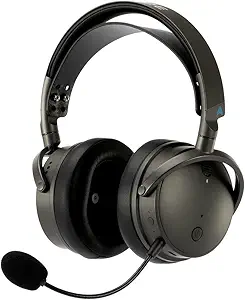
Price: $299
Key specs:
- Closed-back design with planar magnetic drivers
- Detachable boom microphone
- 80+ hour battery life
- Bluetooth 5.3 alongside gaming wireless
- Available in PlayStation and Xbox versions
- Weight: 490g
Audeze brings their planar magnetic expertise to gaming with the Maxwell Wireless, delivering audiophile-grade sound with gaming-specific features.
What makes it special: Unlike most gaming headsets that use conventional dynamic drivers, the Maxwell employs planar magnetic technology for superior detail and spatial accuracy. This translates to a competitive advantage in games where audio positioning is crucial, as well as more immersive experiences in atmospheric single-player games.
During testing across various game genres, I was consistently impressed by how the Maxwell revealed subtle audio cues that other gaming headsets missed. In competitive shooters, enemy footsteps and reloads were precisely positioned in the soundstage, while in story-driven games, environmental details added new layers to the experience.
Pros:
- Exceptional sound quality for a gaming headset
- Class-leading battery life
- Low-latency wireless connection
- Excellent microphone quality
- Simultaneous Bluetooth connection for calls/chat
Cons:
- Expensive for a gaming headset
- Heavier than most competitors
- Large size may not suit everyone
Best for: Serious gamers who refuse to compromise on audio quality and want a competitive edge.
What reviewers say: Sound incredible. Mic is excellent for a wireless gaming mic. I have no side tone issues. Stock pads were very comfortable, although I do like the aftermarket leather pads better.
14. Logitech G Pro X

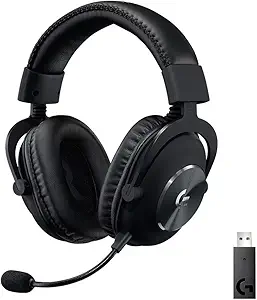
Price: $129
Key specs:
- Closed-back design
- Blue Voice microphone technology
- DTS Headphone:X 2.0 surround sound
- Memory foam ear pads (leatherette and velour included)
- Detachable cables
- Weight: 320g
Developed in collaboration with professional esports players, the G Pro X delivers the essentials gamers need without unnecessary frills.
What makes it special: The G Pro X balances comfort, durability, and gaming-focused sound tuning at a more accessible price point than many premium gaming headsets. The standout feature is the Blue Voice microphone technology, which provides studio-quality voice clarity that’s essential for clear team communication.
In testing across competitive games like Counter-Strike and Valorant, the G Pro X’s sound profile highlighted important audio cues like footsteps and reloads while maintaining enough bass to make explosions and gunfire impactful. The microphone was consistently rated as clear and natural by teammates.
Pros:
- Excellent microphone quality
- Comfortable for long gaming sessions
- Durable aluminum and steel construction
- Includes both leatherette and velour ear pads
- Good sound isolation
Cons:
- Software required for some features
- Somewhat heavy
- Can get warm during intensive gaming sessions
Best for: Competitive gamers who need clear communication and tactical audio without breaking the bank.
What reviewers say: The Logitech G Pro X is one of the best PC gaming headsets around, but its reliance on software means it’s only pretty good on console.
15. JBL Quantum 800
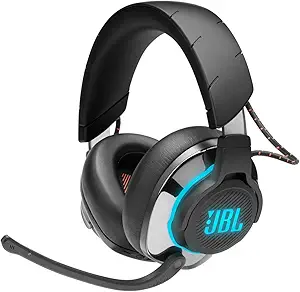
Price: $199
Key specs:
- Closed-back design with active noise cancellation
- 2.4GHz wireless and Bluetooth connections
- JBL QuantumSURROUND
- RGB lighting
- 14-hour battery life
- Weight: 410g
JBL brings their audio expertise to gaming with the Quantum 800, a feature-packed wireless headset with active noise cancellation.
What makes it special: The Quantum 800 is one of the few gaming headsets to incorporate active noise cancellation – a feature that helps keep you immersed in your game even in noisy environments. Combined with JBL’s signature sound quality and a host of gaming-specific features, it’s a versatile option for both competitive and casual gaming.
In testing, the Quantum 800’s spatial audio feature (QuantumSURROUND) created convincing 3D soundscapes that enhanced game immersion while providing accurate positional audio for competitive play. The noise cancellation effectively reduced background distractions, helping maintain focus during intense gaming sessions.
Pros:
- Active noise cancellation
- Good sound quality with strong bass
- Dual wireless connections (gaming + Bluetooth)
- Effective spatial audio
- Flip-to-mute microphone
Cons:
- Shorter battery life than some competitors
- Somewhat heavy
- Software can be complicated
Best for: Gamers who play in noisy environments and appreciate immersive audio with strong bass response.
What reviewers say: The sound is immersive, the noise cancellation is effective for gaming environments, and the dual wireless connections make it versatile for both gaming and everyday use.
Best Budget Headphones
16. Philips SHP9500
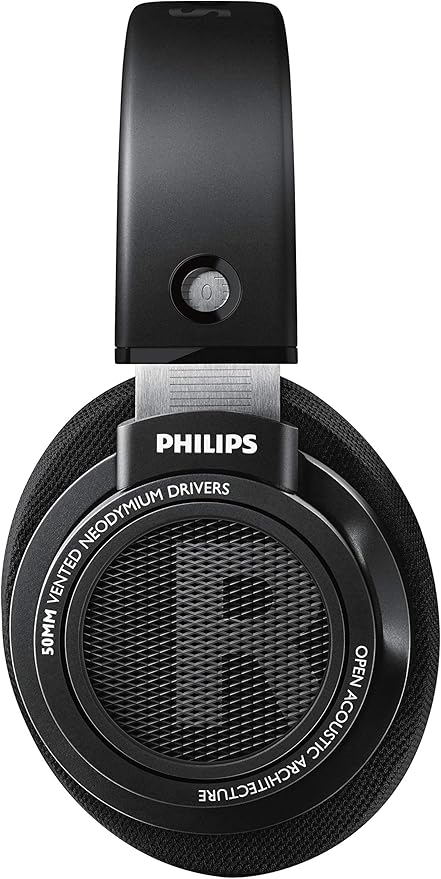
Price: $79
Key specs:
- Open-back design
- 50mm neodymium drivers
- 101 dB sensitivity
- Detachable cable
- Weight: 320g
The SHP9500 has developed a cult following in audiophile circles for delivering sound quality that competes with headphones costing several times more.
What makes it special: These open-back headphones offer a taste of high-end audiophile sound at a fraction of the price. The spacious soundstage, clear midrange, and detailed treble provide a listening experience that belies their budget price tag. While they don’t have the refinement of premium models, they get the fundamentals right in a way that few budget headphones do.
During testing with various music genres, I was consistently impressed by the SHP9500’s ability to present a coherent, spacious soundstage with good instrument separation. Vocals sound natural and present, while acoustic instruments have a lifelike quality rarely found at this price point.
Pros:
- Exceptional value for money
- Wide, spacious soundstage
- Comfortable for long sessions
- Detachable cable with standard 3.5mm connection
- Lightweight design
Cons:
- Limited bass impact (typical of open-backs)
- No isolation from outside noise
- Build quality reflects the budget price
- Non-replaceable ear pads
Best for: Budget-conscious audiophiles and anyone curious about high-quality audio without a significant investment.
What reviewers say: The Philips SHP9500 is well established in the audiophile community as a very good pair of budget headphones.
17. Anker Soundcore Life Q30
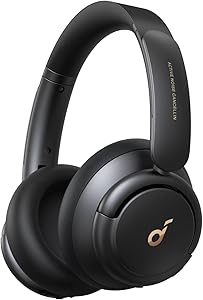
Price: $79
Key specs:
- Closed-back design with active noise cancellation
- Three ANC modes (Transport, Indoor, Outdoor)
- 40-hour battery life (with ANC on)
- LDAC high-resolution codec support
- Multipoint connection
- Weight: 260g
Anker has built a reputation for delivering excellent value tech products, and the Soundcore Life Q30 continues that tradition with features normally found in headphones costing much more.
What makes it special: The Life Q30 packs active noise cancellation, customizable EQ, multiple ANC modes, and impressive battery life into a package that costs a fraction of premium noise-cancelling headphones. While they don’t match the refinement or noise-cancelling effectiveness of high-end models, they get surprisingly close for the price.
In testing across various environments, the noise cancellation proved effective for constant low-frequency sounds like air conditioners and airplane engines. The sound quality out of the box is bass-heavy but becomes much more balanced after some EQ adjustments in the companion app.
Pros:
- Incredible value for money
- Effective noise cancellation
- Outstanding battery life
- Comfortable fit
- Good app with extensive EQ options
Cons:
- Default sound is bass-heavy (though adjustable)
- Build quality lacks premium feel
- ANC not as effective as premium models
- Average call quality
Best for: Budget-conscious users who want noise cancellation and wireless convenience without spending hundreds.
What reviewers say: With good sound, active noise canceling, and battery life, these are some of the best-value headphones on the market. If you have a budget under $100 and want some decent over-ear headphones, these are a terrific option.
18. Audio-Technica ATH-M40x
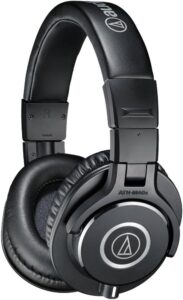
Price: $99
Key specs:
- Closed-back design
- 40mm drivers with rare earth magnets
- Detachable cable (straight and coiled included)
- 90-degree swiveling ear cups
- Weight: 240g
The younger sibling of the popular M50x, the M40x offers more balanced sound at a lower price point.
What makes it special: While the M50x gets most of the attention, many audio professionals actually prefer the M40x for its more neutral frequency response. The slightly flatter sound signature makes it excellent for mixing and monitoring, while still being enjoyable for casual listening.
In my testing, the M40x revealed details in familiar tracks that surprised me given the reasonable price point. The balanced presentation works well across musical genres, from classical to EDM, making it a versatile choice for varied listening tastes.
Pros:
- More balanced sound than the M50x
- Excellent isolation for recording
- Comfortable for long sessions
- Folds for portability
- Durable construction
Cons:
- Less bass impact than the M50x
- Ear pads not as plush as premium models
- Limited soundstage (common for closed-backs)
Best for: Budget-conscious music producers, musicians, and listeners who prefer a more balanced sound signature.
What reviewers say: For the price, these headphones deliver excellent neutral sound that works well for both critical listening and enjoyment. The build quality is surprisingly good for the price point.
19. Grado SR80x
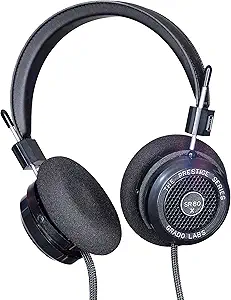
Price: $125
Key specs:
- Open-back design
- 44mm dynamic drivers
- 4-conductor cable
- Handmade in Brooklyn, USA
- Weight: 220g (very light)
Handmade in Brooklyn, New York, the Grado SR80x offers a distinctive sound signature and retro design that stands out from the crowd.
What makes it special: Grado headphones have a house sound unlike any other – vibrant, energetic, and immediate, with forward mids that make vocals and guitars jump out of the mix. The SR80x is their entry-level model, but it embodies the Grado character that has earned them a dedicated following among audiophiles.
During testing with various rock, jazz, and acoustic recordings, the SR80x brought an energy and immediacy to the music that made even familiar tracks feel fresh and exciting. The open-back design creates a sense of space and airiness that closed-back headphones in this price range simply can’t match.
Pros:
- Lively, engaging sound signature
- Excellent midrange clarity
- Lightweight and comfortable
- Distinctive retro design
- Handmade in the USA
Cons:
- On-ear design can be uncomfortable for some
- Limited bass extension
- No isolation (by design)
- Non-detachable cable
Best for: Listeners who prioritize midrange clarity and enjoy rock, folk, jazz, and vocal-centric music.
What reviewers say: Overall very natural, combined with the punchy bass it produces an enjoyable sound for basically any genre, some people call them musical and I agree with them.
20. JBL Tune 760NC
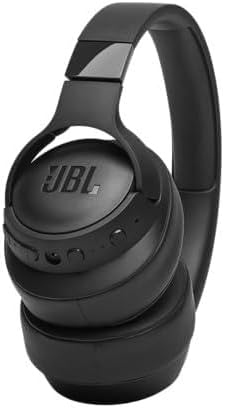
Price: $129
Key specs:
- Closed-back design with active noise cancellation
- 35-hour battery life (with ANC on)
- Multipoint connection
- Foldable design
- Weight: 220g
JBL brings their audio expertise to an affordable noise-cancelling package with the Tune 760NC, offering a taste of premium features at a budget-friendly price.
What makes it special: The Tune 760NC delivers JBL’s signature punchy sound along with effective active noise cancellation at a price point that makes these technologies accessible to more people. While they don’t match the refinement of premium models, they nail the fundamentals that most listeners care about.
In testing, I found the noise cancellation surprisingly effective for the price, particularly with low-frequency sounds like air conditioning and traffic noise. The sound signature is engaging, with the bass emphasis that JBL is known for, making them well-suited for contemporary music genres.
Pros:
- Good value for money
- Effective noise cancellation for the price
- Engaging sound with punchy bass
- Comfortable lightweight design
- Solid battery life
Cons:
- Plastic build feels less premium
- Bass can be overwhelming on some tracks
- ANC not as effective as premium models
- Limited app features
Best for: Budget-conscious listeners who want wireless convenience and noise cancellation without spending a fortune.
What reviewers say: The JBL 760NC offers quite a solid and moderately-above-average sonic performance for wireless headphones in this price tier.
Understanding Headphone Technology and Specifications
Shopping for headphones can be overwhelming with all the technical jargon thrown around. Let’s break down the key specifications and technologies to help you make an informed decision.
Driver Types Explained
The driver is the component that converts electrical signals into sound. Different types have distinct characteristics:
Dynamic Drivers
How they work: A voice coil attached to a diaphragm moves when an electrical current passes through it, creating sound waves.
Pros:
- Cost-effective to manufacture
- Good bass response
- Durable and reliable
- Most common in consumer headphones
Cons:
- Can have higher distortion at extreme volumes
- May not be as fast or detailed as other technologies
Best for: Most listening scenarios; they’re versatile and cost-effective.
Planar Magnetic Drivers
How they work: A thin diaphragm with embedded conductors sits between arrays of magnets. When current flows through the conductors, the entire diaphragm moves uniformly.
Pros:
- Lower distortion, especially in bass
- Faster response time
- More consistent movement across the diaphragm
- Typically more detailed sound
Cons:
- More expensive to manufacture
- Often requires more power (less efficient)
- Usually heavier than dynamic drivers
Best for: Audiophiles seeking detail and accuracy who don’t mind the higher cost and potential need for amplification.
Electrostatic Drivers
How they work: A thin diaphragm is suspended between two electrically charged plates, moving when the electrical field changes.
Pros:
- Extremely low distortion
- Incredible detail and transparency
- Lightning-fast response
Cons:
- Very expensive
- Requires special electrostatic amplifiers
- Typically less bass impact
Best for: Serious audiophiles seeking the ultimate in detail and clarity, regardless of cost or practicality.
Closed-Back vs. Open-Back: Which Is Right for You?
Closed-Back Headphones
What they are: The ear cups are sealed, preventing air (and sound) from passing through.
Pros:
- Better isolation from external noise
- Prevents sound leakage (others can’t hear your music)
- Typically stronger bass response
- More practical for public use
Cons:
- Smaller soundstage (sound feels more “in your head”)
- Can create pressure buildup during long sessions
- May get warmer over time
Best for: Commuting, office use, recording studios, and anywhere you need privacy or isolation.
Open-Back Headphones
What they are: The ear cups have openings (often grilles) that allow air to pass freely.
Pros:
- Wider, more natural soundstage
- Often more comfortable for long sessions
- Better heat dissipation
- More natural, spacious sound
Cons:
- No isolation – you hear everything around you
- Everyone nearby can hear your music
- Typically less bass impact
- Impractical for public use
Best for: Home listening in quiet environments where sound quality is the primary concern.
Key Specifications Explained
Impedance
What it is: Measured in ohms (Ω), impedance indicates how much electrical resistance headphones present to the source device.
Why it matters: Higher impedance headphones (>50 ohms) typically need more power to reach their full potential and may require a dedicated amplifier. Lower impedance headphones (<32 ohms) are easier to drive from portable devices.
Rule of thumb: If you’re using headphones primarily with a phone or laptop, look for impedance under 32 ohms. For home listening with dedicated equipment, higher impedance models often provide better sound quality when properly powered.
Sensitivity
What it is: Measured in decibels per milliwatt (dB/mW), sensitivity indicates how loud headphones get with a given power input.
Why it matters: Higher sensitivity (>100 dB/mW) means the headphones can get louder with less power, making them easier to drive from portable devices. Lower sensitivity (<95 dB/mW) typically requires more power for adequate volume.
Rule of thumb: For portable use without an amplifier, look for sensitivity of 100 dB/mW or higher, especially if the headphones also have higher impedance.
Frequency Response
What it is: The range of frequencies (measured in Hertz) that headphones can reproduce, typically presented as 20Hz-20kHz (the theoretical range of human hearing).
Why it matters: While many headphones boast similar frequency ranges, the actual response curve (how they emphasize different frequencies) matters more than the numbers.
Rule of thumb: Don’t judge headphones by their frequency response numbers alone – listen to them if possible, or rely on reviews that describe how they actually sound.
Wireless Technologies and Codecs
If you’re considering wireless headphones, understanding different Bluetooth codecs can help you make a better choice:
SBC (Subband Coding)
The standard Bluetooth codec supported by all Bluetooth audio devices. It’s adequate but not ideal for audiophile listening.
AAC (Advanced Audio Coding)
Offers better quality than SBC, with particular benefits for Apple users (iPhone, iPad, Mac).
aptX/aptX HD/aptX Adaptive
Qualcomm’s codecs provide higher quality Bluetooth transmission with lower latency, but require both the source device and headphones to support them. Many Android phones support aptX.
LDAC
Sony’s high-resolution codec offers the highest potential quality for Bluetooth transmission (up to 990kbps), but both devices must support it. Most Sony phones and some other Android devices support LDAC.
Rule of thumb: For the best wireless audio quality, match your headphones’ codec capabilities to your device. iPhone users should ensure AAC support, while Android users might benefit from aptX or LDAC.
How to Choose the Right Over Ear Headphones for You
With so many excellent options, how do you pick the right over ear headphones for your specific needs? Here’s a practical decision framework:
1. Consider Your Primary Use Case
- Commuting/Travel: Prioritize wireless, noise-cancelling models with good battery life and portability. The Sony WH-1000XM5, Bose QuietComfort Ultra, or Anker Soundcore Life Q30 (budget option) would excel here.
- Office/Work: Comfort for long wear and good noise isolation are key. The Bose QuietComfort Ultra, Sony WH-1000XM4, or JBL Tune 760NC (budget option) are strong choices.
- Home listening: Sound quality can take priority here, with less concern for portability or noise isolation. Consider the Sennheiser HD 800 S, HiFiMan Ananda, or Philips SHP9500 (budget option).
- Gaming: Look for positional accuracy, microphone quality, and comfort. The Audeze Maxwell, Logitech G Pro X, or JBL Quantum 800 would serve well.
- Music production: Accuracy and detail matter most. The Beyerdynamic DT 770 Pro, Audio-Technica ATH-M50x, or Shure SRH1540 are industry standards.
2. Assess Your Environment
- Quiet spaces: You can enjoy open-back headphones like the Sennheiser HD 800 S or Philips SHP9500 without disturbing others.
- Noisy environments: Closed-back with good isolation (like the Audio-Technica ATH-M50x) or active noise cancellation (like the Bose QuietComfort Ultra) becomes essential.
- Shared spaces: Consider closed-back designs with minimal sound leakage to avoid disturbing others.
3. Consider Practical Factors
- Budget: Set a realistic budget range. Remember that diminishing returns kick in above certain price points.
- Portability needs: Will you be carrying these headphones around? Foldable designs like the Sony WH-1000XM4 or Audio-Technica ATH-M50x are more travel-friendly.
- Connectivity requirements: If you need wireless, consider battery life and supported codecs compatible with your devices.
- Comfort for your anatomy: Ear shape, head size, and whether you wear glasses all affect comfort. If possible, try before you buy or purchase from retailers with good return policies.
4. Think About Your Sound Preferences
- Bass enthusiasts: Look for closed-back dynamics like the Sony WH-1000XM5 or V-Moda Crossfade M-100 Master.
- Midrange focus: Grado SR80x or Sennheiser models typically excel here.
- Detail and clarity: Planar magnetic headphones like the HiFiMan Ananda or high-end dynamics like the Sennheiser HD 800 S offer exceptional detail.
- Neutral, balanced sound: The Audio-Technica ATH-M40x, Sennheiser HD 600 series, or Shure SRH1540 provide more neutral presentations.
Caring for Your Headphones
Proper maintenance can significantly extend the lifespan of your headphones:
General Care Tips
- Store properly: Use the included case or hang on a headphone stand to prevent stress on the headband.
- Clean regularly: Wipe ear pads with a slightly damp microfiber cloth. For deeper cleaning, most ear pads can be removed and hand-washed with mild soap.
- Mind the cables: Always pull from the plug, not the cable, and avoid sharp bends or coiling too tightly.
- Watch the volume: Excessive volume can damage drivers over time (and your hearing!).
- Replace ear pads: For headphones you plan to keep long-term, replacing worn ear pads every 1-2 years maintains comfort and sound quality.
Battery Longevity for Wireless Models
- Avoid complete discharge: Try to charge before the battery is completely depleted.
- Don’t leave constantly plugged in: Once fully charged, unplug to prevent constant trickle charging.
- Store at moderate charge: If storing for long periods, aim for around 50% charge.
- Update firmware: Keep your headphones updated with the latest firmware, which may include battery optimization improvements.
Final Thoughts: Finding Your Perfect Match
The best over ear headphones for you ultimately depend on your specific needs, preferences, and budget. While the Sennheiser HD 800 S might represent the pinnacle of audiophile sound, the Philips SHP9500 could bring more joy if it fits your listening style better – at a fraction of the price.
Don’t be swayed solely by specs or price tags. Instead, consider how the headphones fit into your life and listening habits. The “best” headphones are the ones that bring you the most enjoyment and utility for your specific situation.
Remember that headphone preferences are highly subjective. What sounds “perfect” to one person might sound unbearable to another. When possible, try before you buy, or purchase from retailers with generous return policies.
What are your experiences with any of these headphones? Do you have favorites that didn’t make our list? I’d love to hear about your audio journey in the comments below!
Happy listening!
Check The Best Over Ear Headphones Price on Amazon
FAQS About Best Over Ear Headphones
What is the best brand of over-ear headphones?
Sony is widely regarded as the best brand for over-ear headphones due to its exceptional sound quality, industry-leading noise cancellation, comfort, and reliable battery life—especially models like the Sony WH-1000XM5.
Who makes the best kids headphones?
Puro Sound Labs makes the best kids headphones, offering volume-limiting technology, durable design, and excellent sound quality. Their products balance safety, comfort, and performance, making them a top choice for parents.
Is it worth getting over ear headphones?
Yes, over-ear headphones are worth it for superior sound quality, comfort during long use, and effective noise isolation—ideal for music lovers, gamers, and remote workers seeking immersive audio experiences.
Which are the best on-ear headphones?
The best on-ear headphones include the Bose On-Ear Wireless, Beats Solo3, and Sennheiser HD 250BT, offering a balance of comfort, sound quality, and wireless performance ideal for casual and on-the-go listening.

